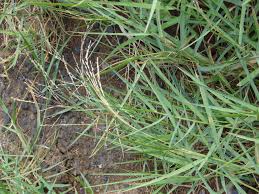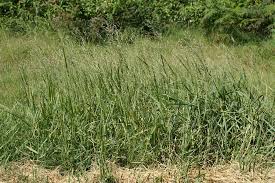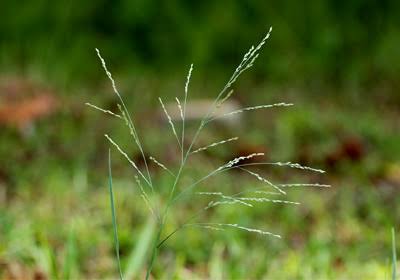Torpedograss (Panicum repens) is a type of grass that can be found in various places. It grows in wet areas like marshes, ditches, and along the edges of water bodies. This grass has long, narrow leaves that can reach up to a foot in length. One distinctive feature of torpedograss is its underground stems, known as rhizomes, which help it spread and establish in new locations.
This invasive plant can be quite problematic for ecosystems and agriculture. It tends to form dense mats, outcompeting native vegetation and affecting biodiversity. Farmers often face challenges when torpedograss invades their fields, as it can be tough to control.
One interesting thing about torpedograss is its ability to adapt to different environments. It can tolerate various soil types and is known for its resilience in both freshwater and brackish water conditions. This adaptability contributes to its widespread distribution and makes it a formidable species in many ecosystems.
Controlling torpedograss can be challenging due to its aggressive growth and ability to regenerate from rhizome fragments. People often employ different methods like herbicides or mechanical removal to manage its spread. However, successfully managing torpedograss requires careful consideration of the specific environment and conditions.
In addition, torpedograss, scientifically known as Panicum repens, is a versatile and adaptive grass that poses challenges in various ecosystems. Its ability to thrive in diverse conditions makes it a formidable presence, and efforts to control its spread often require careful planning and management strategies.
Read Also: The Importance and Uses of Chicory
How To Grow Torpedograss (Panicum repens)

Growing Torpedograss (Panicum repens) can be a complex process, as it is known for its adaptability and ability to thrive in various conditions. Here’s a simple guide to help you understand the basic steps involved in growing Torpedograss:
1. Selection of Planting Site: Choose a site with adequate sunlight, as Torpedograss generally prefers full sun. Ensure that the soil is well-drained and has sufficient moisture, as this grass species often grows in wet areas.
2. Soil Preparation: Torpedograss can tolerate different soil types, but it thrives in fertile soil. Prepare the soil by loosening it with a rake or tiller to improve aeration. Incorporate organic matter, such as compost, to enhance soil fertility.
3. Planting Seeds or Rhizomes: You can start Torpedograss from seeds or rhizomes. If using seeds, sow them directly on the soil surface and lightly cover with a thin layer of soil. For rhizomes, plant them just below the soil surface, ensuring good soil contact.
4. Watering: Torpedograss typically grows in wet areas, so it requires consistent moisture. Water the planting site regularly to keep the soil consistently damp, especially during the germination and establishment phases.
5. Fertilization: While Torpedograss can adapt to different soil conditions, providing it with a balanced fertilizer can encourage healthier growth. Apply a general-purpose fertilizer according to package instructions during the growing season.
6. Maintenance: Monitor the growth of Torpedograss and manage its spread to prevent it from becoming invasive. Regular mowing can help control its height and limit seed production.
7. Invasive Species Consideration: Be aware that Torpedograss is considered an invasive species in many areas. Before planting, check with local authorities to ensure it is legal and environmentally responsible to grow this grass in your region.
8. Control Measures: If Torpedograss starts spreading uncontrollably, consider implementing control measures. This may include using herbicides or physically removing the plants. Always follow recommended guidelines to prevent unintended environmental impacts.
Remember, while Torpedograss can be grown intentionally, it is crucial to be mindful of its invasive nature and potential impact on local ecosystems. Always adhere to local regulations and best practices for responsible gardening and environmental stewardship.
How To Care For Torpedograss (Panicum repens)
Caring for Torpedograss (Panicum repens) requires attention to its specific needs and considerations due to its adaptability and invasive tendencies. Here’s a guide on how to care for Torpedograss:
1. Watering: Torpedograss prefers consistently moist soil, as it naturally grows in wet areas. Regular watering is essential, especially during dry periods, to ensure the soil remains damp. However, avoid waterlogged conditions, as this can lead to other issues.
2. Fertilization: While Torpedograss can adapt to different soil conditions, providing it with a balanced fertilizer during the growing season can promote healthier growth. Use a general-purpose fertilizer and follow the recommended application rates.
3. Monitoring Growth: Regularly monitor the growth of Torpedograss to prevent it from becoming invasive. Control its height by mowing it regularly, which can also help limit seed production. Be vigilant for any signs of uncontrolled spreading and take corrective actions if needed.
4. Pruning and Mowing: Torpedograss can benefit from regular pruning or mowing to control its height and prevent it from overshadowing other plants. This also helps in managing its spread and maintaining a more controlled appearance in the landscape.
5. Invasive Species Management: Given Torpedograss’s invasive nature, it’s crucial to manage its growth responsibly. If it starts spreading uncontrollably, consider implementing control measures. This may involve using herbicides or physically removing the plants following recommended guidelines.
6. Soil Considerations: While Torpedograss is adaptable to different soil types, ensuring well-drained soil is important. Avoid waterlogged conditions, as they can lead to root rot and other issues. Periodically check the soil pH and adjust it if necessary.
7. Local Regulations: Before planting or caring for Torpedograss, be aware of local regulations regarding invasive species. Some regions may have restrictions on growing Torpedograss due to its potential impact on native ecosystems.
8. Responsible Gardening Practices: Practice responsible gardening by containing Torpedograss within desired areas and preventing it from spreading into natural ecosystems. Dispose of clippings and plant materials properly to avoid unintentional spread.
9. Vigilance against Pests and Diseases: Keep an eye out for pests and diseases that may affect Torpedograss. Early detection and appropriate treatment can help maintain the health of the grass.
By following these care guidelines, you can enjoy the presence of Torpedograss in a controlled manner, minimizing its impact on the surrounding environment and ensuring responsible landscaping practices.
Read Also: Growing and Care Guide of Sunflower Seeds
The Uses of Torpedograss (Panicum repens)

Torpedograss (Panicum repens) serves various purposes, although it is essential to note that its invasive nature can sometimes overshadow its potential benefits. Here are some potential uses of Torpedograss:
1. Erosion Control: Torpedograss can be employed for erosion control along waterways and in areas prone to soil erosion. Its extensive root system helps stabilize soil, preventing erosion and promoting water conservation.
2. Livestock Forage: In certain regions, Torpedograss is utilized as forage for livestock, providing fodder for grazing animals. Its relatively high tolerance to grazing makes it a potential resource for supporting livestock.
3. Wetland Restoration: In wetland restoration projects, Torpedograss might be introduced to help establish vegetation and stabilize soil. However, caution is needed to prevent its invasive spread into natural wetland ecosystems.
4. Biofiltration: Due to its adaptability to different water conditions, Torpedograss can be used in biofiltration systems. It helps absorb excess nutrients and contaminants from water, contributing to water purification efforts.
5. Soil Stabilization: Torpedograss’s robust root system aids in soil stabilization. It can be planted in areas where soil erosion is a concern to reinforce the soil structure and prevent sediment runoff.
6. Aesthetic Landscaping: In controlled garden settings, Torpedograss can be used for aesthetic landscaping purposes. Its tall, slender blades can create a visually pleasing backdrop or add texture to landscape designs.
7. Phytoremediation: In some cases, Torpedograss is explored for phytoremediation purposes, helping to absorb and accumulate pollutants from soil and water. However, the potential for its invasive spread needs careful consideration.
8. Biomass Production: Torpedograss has the potential for biomass production. Its rapid growth and adaptability make it a candidate for bioenergy or biomass feedstock in certain agricultural practices.
9. Paper and Fiber Production: Some studies have investigated the use of Torpedograss for paper and fiber production. The plant’s fibrous nature could be harnessed for these purposes, although more research is needed in this area.
It’s important to approach the use of Torpedograss with caution due to its invasive tendencies. While it offers potential benefits in specific applications, proper management and preventive measures are crucial to avoid unintended ecological consequences. Local regulations should be considered to ensure responsible use in various contexts.
Frequently Asked Questions (FAQs)
Q: What is Torpedograss (Panicum repens)?
A: Torpedograss, scientifically known as Panicum repens, is a type of grass that often grows in wet areas like marshes and along water bodies. It is characterized by long, narrow leaves and an extensive underground stem system known as rhizomes.
Q: Is Torpedograss invasive?
A: Yes, Torpedograss is considered invasive in many regions. Its aggressive growth and ability to spread rapidly can outcompete native vegetation, posing challenges for ecosystems and agriculture.
Q: Can Torpedograss be grown in gardens?
A: While Torpedograss can be grown intentionally in gardens, its invasive nature should be taken into account. Responsible management is crucial to prevent uncontrolled spreading.
Q: How can I control Torpedograss in my garden?
A: Control methods for Torpedograss may include herbicide application or physical removal. It’s essential to follow recommended guidelines and be vigilant in managing its growth.
Q: Does Torpedograss have any benefits?
A: Torpedograss has potential uses, including erosion control, livestock forage, and wetland restoration. However, its invasive tendencies require careful consideration in its utilization.
Q: Can Torpedograss be used for landscaping?
A: In controlled garden settings, Torpedograss can be used for aesthetic landscaping due to its tall, slender blades. However, proper containment measures are necessary to prevent invasive spread.
Q: Is Torpedograss suitable for biofiltration?
A: Yes, Torpedograss can be used in biofiltration systems to absorb excess nutrients and contaminants from water, contributing to water purification efforts.
Q: What precautions should be taken when growing Torpedograss?
A: Be aware of local regulations regarding invasive species. Implement responsible gardening practices, monitor growth, and take measures to prevent uncontrolled spreading.
Q: Can Torpedograss be used for phytoremediation?
A: Some studies explore the potential use of Torpedograss for phytoremediation, absorbing pollutants from soil and water. However, its invasive nature needs careful consideration in such applications.
Q: Is Torpedograss suitable for paper and fiber production?
A: There is potential for using Torpedograss in paper and fiber production due to its fibrous nature. However, more research is needed to explore its viability for these purposes.
Read Also: List of 20 Foods That Are Bad for Your Health

